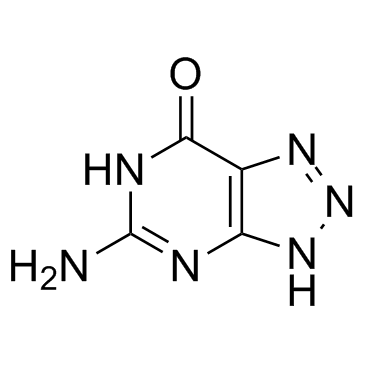8-Azaguanine

8-Azaguanine structure
|
Common Name | 8-Azaguanine | ||
|---|---|---|---|---|
| CAS Number | 134-58-7 | Molecular Weight | 152.114 | |
| Density | 2.6±0.1 g/cm3 | Boiling Point | N/A | |
| Molecular Formula | C4H4N6O | Melting Point | >300 °C(lit.) | |
| MSDS | Chinese USA | Flash Point | 129.1ºC | |
| Symbol |

GHS07 |
Signal Word | Warning | |
|
A Versatile Monoclonal Antibody Specific Against Human DAB2IP.
Monoclon. Antib. Immunodiagn. Immunother. 34 , 246-50, (2015) Human DAB2 interaction protein (DAB2IP) is a member of Ras-GTPase activating protein family and functions as a tumor suppressor, implying it could serve as a prognostic biomarker in cancers. Here we generated a mouse monoclonal antibody, 2A4, directed against... |
|
|
Preparation and preliminary application of monoclonal antibodies to the receptor binding region of Clostridium difficile toxin B.
Mol. Med. Report. 12 , 7712-20, (2015) A previous nationwide Chinese epidemiological study revealed through isolation of A‑B+ Clostridium difficile strains, which produce toxin B (TcdB), but not toxin A TcdA, that the strains are widespread and more frequent in east Asian countries,. The developme... |
|
|
Production and characterization of monospecific and bispecific antibodies against dengue virus NS1 protein.
J. Virol. Methods 220 , 5-12, (2015) Dengue is a mosquito borne infection, which in recent years has become a major international public health concern. Annually, 100 million dengue virus infections are reported worldwide. The nonstructural protein 1 (NS1) of dengue virus is a useful target for ... |
|
|
[Riboflavin overproduction in 4-aminopyrazole[3,4-d]pyrimidine-treated yeast Pichia guilliermondii].
Prikl. Biokhim. Mikrobiol. 38(3) , 268-72, (2002) More than 90 mutants resistant to the adenine analogue 4-aminopyrazole[3,4-d]pyrimidine (4-APP), were isolated from a wild-type strain of yeast Pichia guilliermondii. Some of Appr mutants accumulated noticeable amounts of products absorbing at 260 nm in the c... |
|
|
Intersystem crossing to excited triplet state of aza analogues of nucleic acid bases in acetonitrile.
J. Phys. Chem. A 113(44) , 12088-93, (2009) Excited state characteristics of aza analogues of nucleic acid bases, 8-azaadenine (8AA), 5-azacytosine (5AC), 8-azaguanine (8AG), and 6-azauracil (6AU), in acetonitrile solution were comprehensively investigated with steady state absorption and emission spec... |
|
|
Structure of human PNP complexed with ligands.
Acta Crystallogr. D Biol. Crystallogr. 61 , 856-862, (2005) Purine nucleoside phosphorylase (PNP) is a key enzyme in the purine-salvage pathway, which allows cells to utilize preformed bases and nucleosides in order to synthesize nucleotides. PNP is specific for purine nucleosides in the beta-configuration and exhibit... |
|
|
Characterisation of methionine adenosyltransferase from Mycobacterium smegmatis and M. tuberculosis.
BMC Microbiol. 3 , 12, (2003) Tuberculosis remains a serious world-wide health threat which requires the characterisation of novel drug targets for the development of future antimycobacterials. One of the key obstacles in the definition of new targets is the large variety of metabolic alt... |
|
|
AtAzg1 and AtAzg2 comprise a novel family of purine transporters in Arabidopsis
FEBS Lett. 583(2) , 481-6, (2009) In plants, nucleobase biochemistry is highly compartmented relying upon a well-regulated and selective membrane transport system. In Arabidopsis two proteins, AtAzg1 and AtAzg2, show substantial amino acid sequence similarity to the adenine–guanine–hypoxanthi... |
|
|
Structure and the energy of base pairing in non-natural bases of nucleic acids: the azaguanine-cytosine and azaadenine-thymine base pairs.
Bioorg. Chem. 31 , 367-377, (2003) Watson-Crick optimized geometries and the energies of base pairing for the natural pairs of nucleic bases: adenine-thymine (AT) and guanine-cytosine (GC) have been recalculated by ab initio methods in order to compare results to those found for the non-natura... |
|
|
Expression of the E. coli fpg protein in CHO cells lowers endogenous oxypurine clustered damage levels and decreases accumulation of endogenous Hprt mutations.
Environ. Mol. Mutagen. 47(5) , 311-9, (2006) Endogenous DNA damage clusters--two or more oxidized bases, abasic sites, or strand breaks within about 20 base pairs on opposing strands--can accumulate in unirradiated mammalian cells, and may be significant origins of spontaneous detrimental biological eff... |